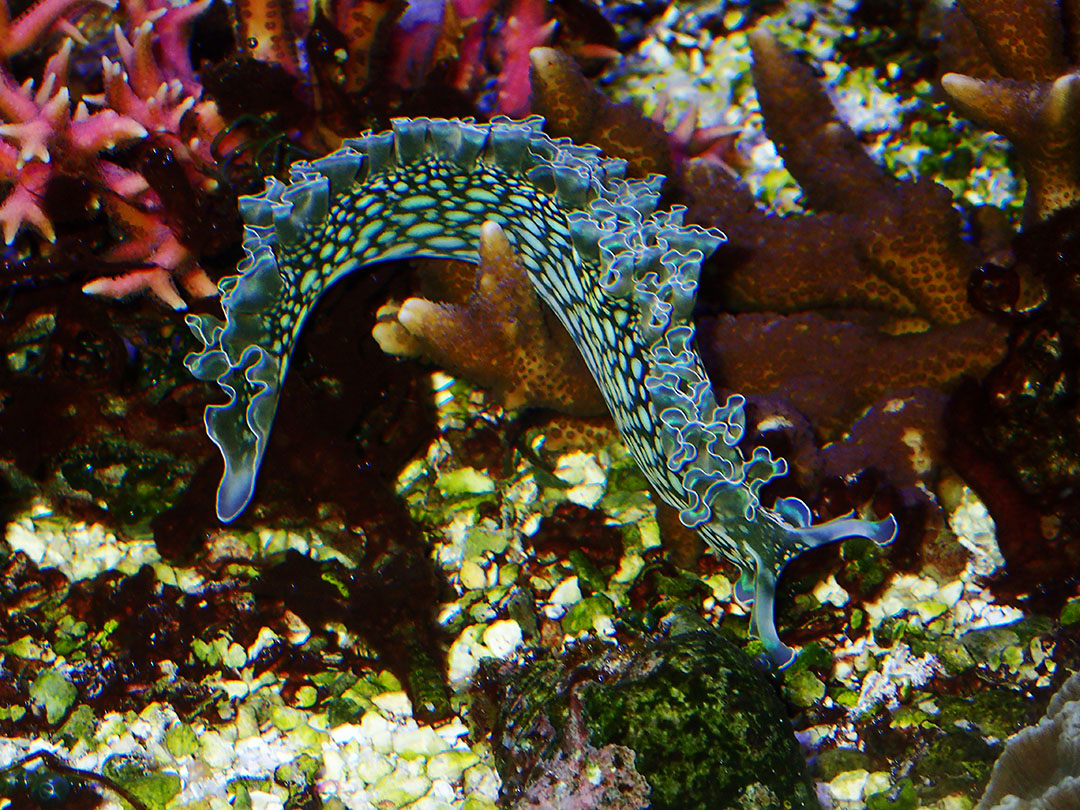Description: A large species, reaching roughly 15 cm when fully extended. E. clarki resembles E. crispata, with which its range partially overlaps. However, they can be distinguished based on several features unique to E. clarki. These include lack of overlap of parapodia at the anterior end, and smaller spots on the body which extend onto the base of the foot (Pierce et al., 2006; a beautiful set of photos showing the differences can be found here at the Sea Slug Forum). This species is commonly sold as “lettuce nudibranch” by online suppliers in North America. It is currently featured in the “Box of Slugs” part of the blog, which highlights observations on the feeding and social behaviors of solar slugs in my office in Rockville, MD.
Note that Krug et al (2016) have synonymized E. clarki with E. crispata, although they look and act differently enough for me to continue using the name E. clarki.
Distribution: Florida Keys (Pierce et al., 2006).
Food plants: Bryopsis, Penicillus, Halimeda
Kleptoplasty: Long-term
Development: Lecithotrophic (but really short). Eggs hatch after 15-20 days, and veligers settle within a few days after hatching. Juveniles feed on Bryopsis plumosa, but not B. pennata. For more information, please see Breeding and Rearing Elysia Clarki.
Scientific Literature
Mahadevan P, Middlebrooks ML. (2020) Bacterial diversity in the clarki ecotype of the photosynthetic sacoglossan, Elysia crispata. Microbiologyopen. 9: e1098. [Cl]
Middlebrooks, M.L., Curtis, N.E., Pierce, S.K. (2020) The complete disappearance of a long standing sacoglossan sea slug
population following Hurricane Irma, despite recovery of the local
algal community. Symbiosis /doi.org/10.1007/s13199-020-00670-3 [NH] [Cl]
Dionisio, G., Faleiro, F; Bilan, M; Rosa, Ines C.; Pimentel, M (2017) Impact of climate change on the ontogenetic, development of ‘solar-powered’ sea slugs. Marine Ecology Progress Series 578: 87-97 [F] [NH] [Cl]
Krug, P.J., Vendetti, J.E., Valdes, A. (2016) Molecular and morphological systematics of Elysia Risso, 1818 (Heterobranchia: Sacoglossa) from the Caribbean region. Zootaxa 4148: 1-137 Thorough analysis of Elysia, rendering many names used on this site obsolete.
Curtis, N.E., Middlebrooks, M.L., Schwartz, J.A., Pierce, S.K. (2015) Kleptoplastic sacoglossan species have very different capacities for plastid maintenance despite utilizing the same algal donors. Symbiosis, 65 (1), pp. 23-31 [F] [K] [Cl] [Pp]
Pierce, S.K., Curtis, N.E., Middlebrooks, M.L. (2015) Sacoglossan sea slugs make routine use of photosynthesis by a variety of species-specific adaptations. Invert. Biol. 134:103-115 [HT] [Cl] [Ti] [Vi]
Christa, G., Händeler, K., Kück, P., Vleugels, M., Franken, J., Karmeinski, D., Wägele, H. (2014) Phylogenetic evidence for multiple independent origins of functional kleptoplasty in Sacoglossa (Heterobranchia, Gastropoda). Organisms Diversity and Evolution, 15 (1), pp. 23-36 [K] [F] [Cl] [Pp] [Pt] [Zu]
Middlebrooks, M.L., Bell, S.S., Curtis, N.E., Pierce, S.K. (2014) Atypical plant-herbivore association of algal food and a kleptoplastic sea slug (Elysia clarki) revealed by DNA barcoding and field surveys. Marine Biology, 161 (6), pp. 1429-1440.
Middlebrooks, M.L., Bell, S.S., Curtis, N.E., Pierce, S.K. (2014) Atypical plant-herbivore association of algal food and a kleptoplastic sea slug (Elysia clarki) revealed by DNA barcoding and field surveys. Marine Biology, 161 (6), pp. 1429-1440. Abstract [F] [K] [Cl]
Middlebrooks, M.L., Bell, S.S., Pierce, S.K. (2012) The kleptoplastic sea slug Elysia clarki prolongs photosynthesis by synthesizing chlorophyll a and b. Symbiosis, 57 (3), pp. 127-132. Page1 [HT] [K] [Cl]
Middlebrooks, M.L., Pierce, S.K., Bell, S.S. (2011) Foraging behavior under starvation conditions is altered via photosynthesis by the marine gastropod, Elysia clarki. PLoS ONE, 6 (7), art. no. e22162. PDF [BN] [K] [Cl]
Curtis, N.E., Schwartz, J.A., Pierce, S.K. (2010) Ultrastructure of sequestered chloroplasts in sacoglossan gastropods with differing abilities for plastid uptake and maintenance. Invertebrate Biology, 129 (4), pp. 297-308. Abstract [K] [Cl] [Ru] [Pa]
Curtis, N.E., Pierce, S.K., Massey, S.E., Schwartz, J.A., Maugel, T.K. (2007) Newly metamorphosed Elysia clarki juveniles feed on and sequester chloroplasts from algal species different from those utilized by adult slugs. Marine Biology, 150 (5), pp. 797-806. PDF [F] [K] [Cl]
Pierce, S.K., Curtis, N.E., Massey, S.E., Bass, A.L., Karl, S.A., Finney, C.M. (2006) A morphological and molecular comparison between Elysia crispata and a new species of kleptoplastic sacoglossan sea slug (Gastropoda: Opisthobranchia) from the Florida Keys, USA. Molluscan Research, 26 (1), pp. 23-38. Abstract [F] [K] [NH] [Cr] [Cl]
Curtis, N.E., Massey, S.E., Pierce, S.K. (2006) The symbiotic chloroplasts in the sacoglossan Elysia clarki are from several algal species. Invertebrate Biology, 125 (4), pp. 336-345.HTML [F] [K] [Cl]

Recent Comments